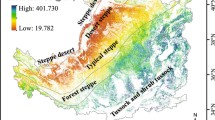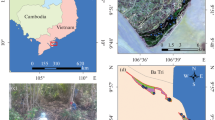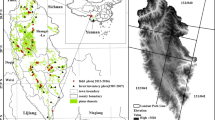Abstract
The spatial distribution of forest biomass is closely related with carbon cycle, climate change, forest productivity, and biodiversity. Efficient quantification of biomass provides important information about forest quality and health. With the rising awareness of sustainable development, the ecological benefits of forest biomass attract more attention compared to traditional wood supply function. In this study, two nonparametric modeling approaches, random forest (RF) and support vector machine were adopted to estimate above ground biomass (AGB) using widely used Landsat imagery in the region, especially within the ecological forest of Fuyang District in Zhejiang Province, China. Correlation analysis was accomplished and model parameters were optimized during the modeling process. As a result, the best performance modeling method RF was implemented to produce an AGB estimation map. The predicted map of AGB in the study area showed obvious spatial variability and demonstrated that within the current ecological forest zone, as well as the protected areas, the average of AGB were higher than the ordinary forest. The quantification of AGB was proven to have a close relationship with the local forest policy and management pattern, which indicated that combining remote-sensing imagery and forest biophysical property would provide considerable guidance for making beneficial decisions.





Similar content being viewed by others
References
Avitabile V, Baccini A, Friedl MA, Schmullius C (2012) Capabilities and limitations of Landsat and land cover data for aboveground woody biomass estimation of Uganda. Remote Sens Environ 117:366–380
Baret F, Guyot G (1991) Potentials and limits of vegetation indexes for lai and apar assessment. Remote Sens Environ 35(2–3):161–173
Berner LT, Alexander HD, Loranty MM, Ganzlin P, Mack MC, Davydov SP, Goetz SJ (2015) Biomass allometry for alder, dwarf birch, and willow in boreal forest and tundra ecosystems of far northeastern Siberia and north-central Alaska. For Ecol Manag 337:110–118
Breiman L (2001) Random forests. Mach Learn 45(1):5–32
Chang CC, Lin CJ (2011) LIBSVM: a library for support vector machines. ACM Trans Intell Syst Technol 2(3):1–27
Crist EP, Cicone RC (1984) A physically-based transformation of thematic mapper data—the TM tasseled cap. IEEE Trans Geosci Remote Sens 22(3):256–263
Du HQ, Cui RR, Zhou GM, Shi YJ, Xu XJ, Fan WL, Lü YL (2010) The responses of Moso bamboo (Phyllostachys heterocycla var. pubescens) forest aboveground biomass to Landsat TM spectral reflectance and NDVI. Acta Ecol Sin 30(5):257–263
Du HQ, Zhou GM, Ge HL, Fan WY, Xu XJ, Fan WL, Shi YJ (2012) Satellite-based carbon stock estimation for bamboo forest with a non-linear partial least square regression technique. Int J Remote Sens 33(6):1917–1933
Du L, Zhou T, Zou ZH, Zhao X, Huang KC, Wu H (2014) Mapping forest biomass using remote sensing and national forest inventory in China. Forests 5(6):1267–1283
Duane MV, Cohen WB, Campbell JL, Hudiburg T, Turner DP, Weyermann DL (2010) Implications of alternative field-sampling designs on Landsat-based mapping of stand age and carbon stocks in Oregon forests. For Sci 56(4):405–416
Dube T, Mutanga O (2015) Evaluating the utility of the medium-spatial resolution Landsat 8 multispectral sensor in quantifying aboveground biomass in uMgeni catchment, South Africa. ISPRS J Photogramm Remote Sens 101:36–46
Eckert S (2012) Improved forest biomass and carbon estimations using texture measures from worldview-2 satellite data. Remote Sens 4(12):810–829
Foody GM, Boyd DS, Cutler MEJ (2003) Predictive relations of tropical forest biomass from Landsat TM data and their transferability between regions. Remote Sens Environ 85(4):463–474
Gao BC (1996) NDWI—a normalized difference water index for remote sensing of vegetation liquid water from space. Remote Sens Environ 58(3):257–266
Gao J, Liu YS (2012) Deforestation in Heilongjiang Province of China, 1896–2000: severity, spatiotemporal patterns and causes. Appl Geogr 35(1–2):345–352
Guo Y, Li ZY, Zhang X, Chen EX, Bai LN, Tian X, He QS, Feng Q, Li WM (2012) Optimal support vector machines for forest above-ground biomass estimation from multisource remote sensing data. In: Geoscience and remote sensing symposium (IGARSS), 2012 IEEE International, pp 6388–6391
Hame T, Salli A, Andersson K, Lohi A (1997) A new methodology for the estimation of biomass of coniferdominated boreal forest using NOAA AVHRR data. Int J Remote Sens 18(15):3211–3243
Han N, Du HQ, Zhou GM, Xu XJ, Cui RR, Gu CY (2013) Spatiotemporal heterogeneity of Moso bamboo aboveground carbon storage with Landsat Thematic Mapper images: a case study from Anji County, China. Int J Remote Sens 34(14):4917–4932
Hirata Y, Tabuchi R, Patanaponpaiboon P, Poungparn S, Yoneda R, Fujioka Y (2014) Estimation of aboveground biomass in mangrove forests using high-resolution satellite data. J For Res 19(1):34–41
Ji L, Wylie BK, Nossov DR, Peterson B, Waldrop MP, Mcfarland JW, Rover J, Hollingsworth TN (2012) Estimating aboveground biomass in interior Alaska with Landsat data and field measurements. Int J Appl Earth Obs Geoinf 18:451–461
Kelsey K, Neff J (2014) Estimates of aboveground biomass from texture analysis of Landsat imagery. Remote Sens 6(7):6407–6422
Koch B (2010) Status and future of laser scanning, synthetic aperture radar and hyperspectral remote sensing data for forest biomass assessment. ISPRS J Photogramm Remote Sens 65(6):581–590
Labrecque S, Fournier RA, Luther JE, Piercey D (2006) A comparison of four methods to map biomass from Landsat-TM and inventory data in western Newfoundland. For Ecol Manag 226(1–3):129–144
Latifi H, Fassnacht FE, Hartig F, Berger C, Hernández J, Corvalán P, Koch B (2015) Stratified aboveground forest biomass estimation by remote sensing data. Int J Appl Earth Obs Geoinf 38:229–241
Lek S, Guégan JF (1999) Artificial neural networks as a tool in ecological modelling, an introduction. Ecol Model 120(2–3):65–73
Li WH (2004) Degradation and restoration of forest ecosystems in China. For Ecol Manag 201(1):33–41
Liao YH, Chen HY, Zheng W, Chen CG, Liu LW (2008) Study on community of Fengshui woods and the value of application in the construction of ecological public welfare forest. J Subtrop Resour Environ 3(2):42–48
Lim K, Treitz P, Wulder M, St-Onge B, Flood M (2003) LiDAR remote sensing of forest structure. Prog Phys Geogr 27(1):88–106
Liu QX, Chang J, Jiang B, Yuan WG, Qi L, Zhu JZ, Ge Y (2005) The biomass of the evergreen broad-leaved ecological public-welfare forests in Zhejiang, East China. Acta Ecol Sin 25(9):2139–2144
Lu DS (2005) Aboveground biomass estimation using Landsat TM data in the Brazilian Amazon. Int J Remote Sens 26(12):2509–2525
Lu DS (2006) The potential and challenge of remote sensing-based biomass estimation. Int J Remote Sens 27(7):1297–1328
Lu DS, Chen Q, Wang GX, Liu LJ, Li GY, Moran E (2014) A survey of remote sensing-based aboveground biomass estimation methods in forest ecosystems. Int J Digit Earth 9(1):63–105
Main-Knorn M, Moisen GG, Healey SP, Keeton WS, Freeman EA, Hostert P (2011) Evaluating the remote sensing and inventory-based estimation of biomass in the western Carpathians. Remote Sens 3(12):1427–1446
Mountrakis G, Im J, Ogole C (2011) Support vector machines in remote sensing: a review. ISPRS J Photogramm Remote Sens 66(3):247–259
Mutanga O, Adam E, Cho MA (2012) High density biomass estimation for wetland vegetation using WorldView-2 imagery and random forest regression algorithm. Int J Appl Earth Obs Geoinf 18:399–406
Návar J (2009) Allometric equations for tree species and carbon stocks for forests of northwestern Mexico. For Ecol Manag 257(2):427–434
Ohmann JL, Gregory MJ, Roberts HM (2014) Scale considerations for integrating forest inventory plot data and satellite image data for regional forest mapping. Remote Sens Environ 151:3–15
Pflugmacher D, Cohen WB, Kennedy RE (2012) Using Landsat-derived disturbance history (1972–2010) to predict current forest structure. Remote Sens Environ 122:146–165
Powell SL, Cohen WB, Healey SP, Kennedy RE, Moisen GG, Pierce KB, Ohmann JL (2010) Quantification of live aboveground forest biomass dynamics with Landsat time-series and field inventory data: a comparison of empirical modeling approaches. Remote Sens Environ 114(5):1053–1068
Qi XK, Wang KL, Zhang CH (2013) Effectiveness of ecological restoration projects in a karst region of southwest China assessed using vegetation succession mapping. Ecol Eng 54:245–253
Roy PS, Ravan SA (1996) Biomass estimation using satellite remote sensing data—an investigation on possible approaches for natural forest. J Biosci 21(4):535–561
Roy DP, Wulder MA, Loveland TR, Allen RG, Anderson MC, Helder D, Irons JR, Johnson DM, Kennedy R, Scambos TA (2014) Landsat-8: science and product vision for terrestrial global change research. Remote Sens Environ 145:154–172
Stow D, Niphadkar M, Kaiser J (2005) MODIS-derived visible atmospherically resistant index for monitoring chaparral moisture content. Int J Remote Sens 26(17):3867–3873
Tang LN, Shao GF, Dai LM (2009) Roles of digital technology in China’s sustainable forestry development. Int J Sust Dev World Ecol 16(2):94–101
Teillet PM, Guindon B, Goodenough DG (1982) On the slope-aspect correction of multispectral scanner data. Can J Remote Sens 8(2):84–106
Tian X, Li ZY, Su ZB, Chen EX, van der Tol C, Li X, Guo Y, Li LH, Ling FL (2014) Estimating montane forest above-ground biomass in the upper reaches of the Heihe River Basin using Landsat-TM data. Int J Remote Sens 35(21):7339–7362
Vaglio Laurin G, Chen Q, Lindsell JA, Coomes DA, Frate FD, Guerriero L, Pirotti F, Valentini R (2014) Above ground biomass estimation in an African tropical forest with lidar and hyperspectral data. ISPRS J Photogramm Remote Sens 89(26):49–58
Wang XK, Feng ZW, Ouyang ZY (2001) The impact of human disturbance on vegetative carbon storage in forest ecosystems in China. For Ecol Manag 148(1–3):117–123
Wang XC, Shao GF, Chen H, Lewis BJ, Qi G, Yu DP, Zhou L, Dai LM (2013) An Application of remote sensing data in mapping landscape-level forest biomass for monitoring the effectiveness of forest policies in Northeastern China. Environ Manag 52(3):612–620
Xie YC, Sha ZY, Yu M, Bai YF, Zhang L (2009) A comparison of two models with Landsat data for estimating above ground grassland biomass in Inner Mongolia, China. Ecol Model 220(15):1810–1818
Yang J, Yuan WG, Jiang B, Zhu JR, Wen LN (2007) Effect of environment on biomass of major ecological forest in Zhejiang. J Zhejiang For Sci Technol 27(02):20–23
Yin RS, Yin GP (2010) China’s primary programs of terrestrial ecosystem restoration: initiation, implementation, and challenges. Environ Manag 45(3):429–441
Yu DY, Shi PJ, Han GY, Zhu WQ, Du SQ, Xun B (2011) Forest ecosystem restoration due to a national conservation plan in China. Ecol Eng 37(9):1387–1397
Yuan WG, Jiang B, Ge YJ, Zhu JR, Shen AH (2009) Study on biomass model of key ecological forest in Zhejiang Province. J Zhejiang For Sci Technol 29(2):1–5
Yuan JG, Niu Z (2008) Evaluation of atmospheric correction using FLAASH. In: 2008 International workshop on earth observation and remote sensing applications, EORSA, pp 1–6
Zhang F, Du Q, Ge HL, Liu AX, Fu WJ, Ji BY (2012) Spatial distribution of forest carbon in Zhejiang Province with geostatistics based on CFI sample plots. Acta Ecol Sin 32(16):5275–5286
Zhang J, Ge Y, Chang J, Jiang B, Jiang H, Peng CH, Zhu JR, Yuan WG, Qi LZ, Yu SQ (2007) Carbon storage by ecological service forests in Zhejiang Province, subtropical China. For Ecol Manag 245(1–3):64–75
Zhang J, Huang S, Hogg EH, Lieffers V, Qin Y, He F (2014) Estimating spatial variation in Alberta forest biomass from a combination of forest inventory and remote sensing data. Biogeosciences 11(9):2793–2808
Zhang XY, Kondragunta S (2006) Estimating forest biomass in the USA using generalized allometric models and MODIS land products. Geophys Res Lett 33(9):370–386
Zheng DL, Rademacher J, Chen JQ, Crow T, Bresee M, Le Moine J, Ryu SR (2004) Estimating aboveground biomass using Landsat 7 ETM + data across a managed landscape in northern Wisconsin, USA. Remote Sens Environ 93(3):402–411
Zhu XL, Liu DS (2015) Improving forest aboveground biomass estimation using seasonal Landsat NDVI time-series. ISPRS J Photogramm Remote Sens 102:222–231
Acknowledgements
The authors are thankful to the USGS and NASA for the open archives of Landsat imagery, and would like to give sincere thanks to the R Development Team for the open-source package for statistical analysis. The authors also thank the Editor and anonymous reviewers for their constructive comments, suggestions, and help in enhancing the manuscript.
Author information
Authors and Affiliations
Corresponding author
Additional information
Project funding: The authors are grateful for the support of Chinese Ministry of Environmental Protection (No. STSN-05-11), Ministry of Science and Technology of the People’s Republic of China (No. 2015BAC02B00) and Science Technology Department of Zhejiang Province (No. 2015F50056).
The online version is available at http://www.springerlink.com.
Corresponding editor: Hu Yanbo.
Rights and permissions
About this article
Cite this article
Wu, C., Tao, H., Zhai, M. et al. Using nonparametric modeling approaches and remote sensing imagery to estimate ecological welfare forest biomass. J. For. Res. 29, 151–161 (2018). https://doi.org/10.1007/s11676-017-0404-9
Received:
Accepted:
Published:
Issue Date:
DOI: https://doi.org/10.1007/s11676-017-0404-9




